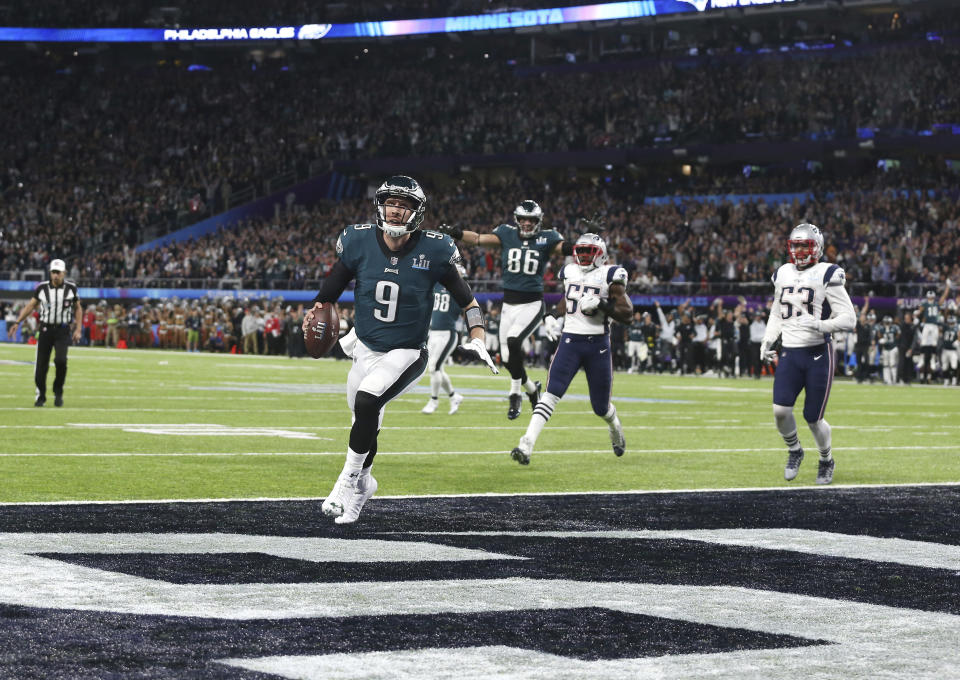Eagles' 'Philly Special' has its roots in small-town South Carolina
One of the most iconic plays in Super Bowl history – the Eagles’ “Philly Special” trick play used on fourth-and-goal against the New England Patriots – was born as “Detroit,” but not in Detroit.
Via a story by The MMQB’s Robert Klemko, it was born on a dirt baseball field in West Columbia, S.C. by a man named Hunter Spivey.
In 2011, Spivey was at a new school, Gray Military Academy (now Gray Military Academy), and was in charge of building the football program from scratch. Many of the student-athletes at Gray were South Carolinians who needed a year or two of post-graduate work to get their grades together or get their standardized testing scores up to get a spot at a college program.
As a new school, things were spartan. There was no locker room, so players dressed for practice in a parking lot; there wasn’t a well-manicured field, so practice was held on a baseball field – with no grass.

But the lack of facilities didn’t mean a lack of creativity; early in that first season, Spivey came up with a trick play for the goal line. He had so many creative plays his players called them “Spivey Specials.”
Former Gray wide receiver Evan Stone told Klemko, “He’s like a mad scientist.”
Spivey called the play “Detroit” – the D stands for direct snap – and ran it successfully several times in 2011.
A year later, Spivey was at a coaching clinic and began chatting with them-Clemson offensive coordinator Chad Morris. Spivey told Morris about the two-point play he was using, a trick play that had a near-perfect success rate, and Morris to try it with basically dared Morris to try it with the Tigers.
“I told him, ‘you ain’t gon’ run it’,” Spivey recalled.
But Morris said he would, and two weeks later called Spivey for more information on the play.
“He drew it up right then and there on a napkin for me,” says Morris. “Now, knowing a play on a napkin is one thing, but knowing how to coach it is another thing.”
[Batter up: Join a Yahoo Fantasy Baseball league for free today]
But Morris figured it out. Clemson ran the play a handful of times, with current Texans receiver DeAndre Hopkins completing a pass to Tajh Boyd on a two-point play in 2012.
After that, other teams started using it. Coach Todd Dodge said Westlake High in Texas, alma mater of Eagles’ quarterback Nick Foles, first ran it in 2014; after Philadelphia used it in the Super Bowl, former Westlake quarterback Sam Ehlinger, now playing at Texas, posted a clip of himself running the play on Twitter.
Even New England used a version of the play, in 2015, with Tom Brady catching a pass for a first down; ironically, it happened against Philadelphia. In 2016, the Chicago Bears used it, with receiver Cam Meredith throwing a touchdown pass to quarterback Matt Barkley in Week 17 against the Vikings.
Eagles assistant Press Taylor remembered the play last year, and suggested that the team install it for the postseason.
“I think the key to it,” former Bears coordinator Dowell Loggains said, “is that you have a receiver who can actually throw the ball reliably. We knew Cam could, because he played quarterback early in college.”
Tight end Trey Burton, who threw the touchdown to Foles, was a high school quarterback good enough to be recruited by Florida to play the position.
Now the offensive coordinator at Valdosta (Ga.) High, Spivey still loves a good trick play.
“It’s more satisfying than a good iso run or a touchdown pass,” he said. “No doubt about it. When something like that works, it’s a big deal.”
Less than a month ago, it worked on football’s biggest stage.



